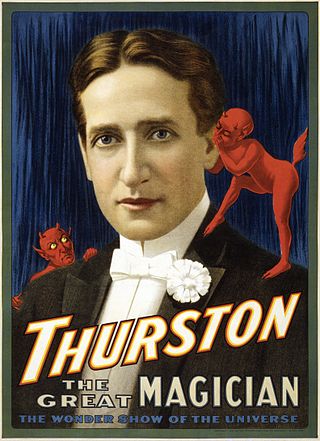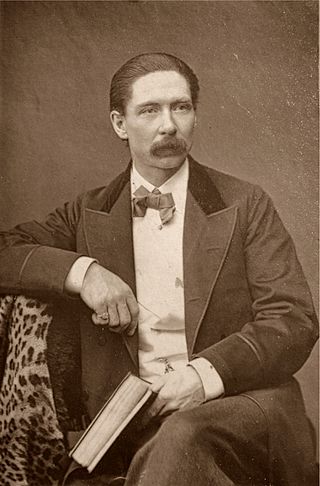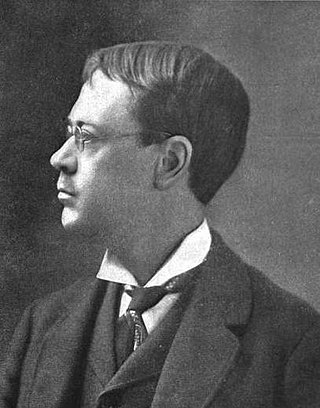
The Evanion Collection is a collection of printed Victorian ephemera in the British Library created by the conjurer, ventriloquist and humorist Henry Evans who used the stage name 'Evanion'. [1]

The Evanion Collection is a collection of printed Victorian ephemera in the British Library created by the conjurer, ventriloquist and humorist Henry Evans who used the stage name 'Evanion'. [1]
The collection of around 5,000 items was purchased by the British Museum Library in 1895 and includes: [1]
Harry Houdini described seeing the collection for the first time as follows:
With some hesitancy of speech but the loving touch of a collector he opened his parcel. "I have brought you, sir, only a few of my treasures, sir, but if you will call - " I heard no more. I remember only raising my hands before my eyes, as if I had been dazzled by a sudden shower of diamonds. In his trembling hands lay priceless treasures for which I had sought in vain … In the presence of his collection I lost all track of time. [2]
Many items from the original collection relating to magic were acquired by Houdini and are now owned by the Harry Ransom Humanities Research Center at the University of Texas at Austin. [3] [4]

The hobby of collecting includes seeking, locating, acquiring, organizing, cataloging, displaying, storing, and maintaining items that are of interest to an individual collector. Collections differ in a wide variety of respects, most obviously in the nature and scope of the objects contained, but also in purpose, presentation, and so forth. The range of possible subjects for a collection is practically unlimited, and collectors have realised a vast number of these possibilities in practice, although some are much more popular than others.

Erik Weisz, known as Harry Houdini, was a Hungarian-American escape artist, illusionist, and stunt performer, and aviator noted for his escape acts.

A trade card is a small card, similar to a visiting card, formerly distributed to advertise businesses. Larger than modern business cards, they could be rectangular or square, and often featured maps useful for locating a business in the days before house numbering. They first became popular at the end of the 17th century in Paris, Lyon and London.

Ephemera are items which were not originally designed to be retained or preserved, but have been collected or retained. The word is etymologically derived from the Greek ephēmeros ‘lasting only a day’. The word is both plural and singular.

Harry Kellar was an American magician who presented large stage shows during the late 19th and early 20th centuries.

The National Library of Australia (NLA), formerly the Commonwealth National Library and Commonwealth Parliament Library, is the largest reference library in Australia, responsible under the terms of the National Library Act 1960 for "maintaining and developing a national collection of library material, including a comprehensive collection of library material relating to Australia and the Australian people", thus functioning as a national library. It is located in Parkes, Canberra, ACT.

Howard Thurston was a stage magician from Columbus, Ohio, United States. As a child, he ran away to join the circus, where his future partner Harry Kellar also performed. Thurston was deeply impressed after he attended magician Alexander Herrmann's magic show and was determined to equal his work. He eventually became the most famous magician of his time. Thurston's traveling magic show was the biggest one of all; it was so large that it needed eight train cars to transport his road show.

The Wellcome Library is a free library and Museum based in central London. It was developed from the collection formed by Sir Henry Wellcome (1853–1936), whose personal wealth allowed him to create one of the most ambitious collections of the 20th century. Henry Wellcome's interest was the history of medicine in a broad sense and included subjects such as alchemy or witchcraft, but also anthropology and ethnography. Since Henry Wellcome's death in 1936, the Wellcome Trust has been responsible for maintaining the Library's collection and funding its acquisitions. The library is free and open to the public.

The Clockmakers’ Museum in London, England, is believed to be the oldest collection specifically of clocks and watches in the world. The collection belongs to and is administered by the Clockmakers’ Charity, affiliated to the Worshipful Company of Clockmakers, founded in 1631 by Royal Charter. Since 2015 it has been housed in a gallery provided by the Science Museum in South Kensington, having formerly been located in the Guildhall complex in the City of London since 1874, where it first opened to the public. Admission is free.

Jay Marshall (James Ward Marshall) (August 29, 1919 – May 10, 2005) was an American magician and ventriloquist.

John Nevil Maskelyne was an English stage magician and inventor of the pay toilet, along with other Victorian-era devices. He worked with magicians George Alfred Cooke and David Devant, and many of his illusions are still performed today. His book Sharps and Flats: A Complete Revelation of the Secrets of Cheating at Games of Chance and Skill is considered a classic overview of card sharp practices. In 1914 he founded the Occult Committee, a group to "investigate claims to supernatural power and to expose fraud".
The Houdini Museum is located at Scranton, Pennsylvania. Harry Houdini appeared in Scranton and did several special challenges there. His brother, Hardeen, also appeared in Scranton and in its sister city, Wilkes-Barre. The longest engagement of Houdini's career was in this area of northeast Pennsylvania when he spent two full seasons with the Welsh Brothers Circus. Documents and letters attesting to this are on display in the museum's renovated 125-year-old building and on its website. Houdini performed at Sylvester Z. Poli's theater for in Scranton, which was part of the Keith-Albee-Orpheum circuit at the time. This would later become the RKO Pictures circuit.

The Badminton Library, called in full The Badminton Library of Sports and Pastimes, was a sporting and publishing project conceived by Longmans Green & Co. and edited by Henry Somerset, 8th Duke of Beaufort (1824–1899). Between 1885 and 1902 it developed into a series of sporting books which aimed to cover comprehensively all major sports and pastimes. The books were published in London by Longmans, Green & Co. and in Boston by Little, Brown & Co.

Magic, which encompasses the subgenres of illusion, stage magic, and close-up magic, among others, is a performing art in which audiences are entertained by tricks, effects, or illusions of seemingly impossible feats, using natural means. It is to be distinguished from paranormal magic which are effects claimed to be created through supernatural means. It is one of the oldest performing arts in the world.

Henry Evans was a conjurer, ventriloquist and humorist, born in Kennington, South London, who used the stage name Evanion. Performances in front of members of the British Royal Family, including Queen Victoria at Sandringham, and the Prince of Wales and Princess Alexandra at Marlborough House, enabled him to use the name "The Royal Conjuror" in his publicity.
The Book Collectors' Society of Australia (BCSA) has been a focus for Australian book collectors to share their enthusiasm for books of all kinds, Australian and foreign, including antiquarian books. It was founded in Sydney in 1944, and its journal Biblionews has been published since 1947. There is also an equally active branch in Melbourne. An independent cognate society also exists in Adelaide.

Henry Ridgely Evans was an American magician and journalist.

Laura Seddon Greeting Card Collection is a collection of 19th to early 20th century British greeting cards, housed in the All Saints Library of Manchester Metropolitan University, England. The collection contains 32,000 cards by various publishers, including Britain's first commercially-produced Christmas card. Laura Seddon donated her collection to the university in 1992.
NIVAL (National Irish Visual Arts Library) is a public research resource which is dedicated to the documentation of twentieth- and twenty-first-century Irish visual art and design. It collects, stores and makes available for research documentation of Irish art and design in all media. NIVAL's collection policy encompasses Irish art and design from the entire island, Irish art and design abroad, and non-Irish artists and designers working in Ireland. NIVAL is sustained by material contributions from artists, arts organisations and arts workers. Information is also acquired from galleries, cultural institutions, critics, the art and design industries, and national and local authorities responsible for the visual arts. NIVAL is housed on the campus of the National College of Art and Design (NCAD) in Dublin.

The Houdini Museum of New York is a museum exhibiting memorabilia related to the escape artist, Harry Houdini. It is located at Fantasma Magic, a retail magic manufacturer.